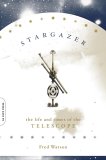Summary | Excerpt | Reviews | Beyond the Book | Readalikes | Genres & Themes | Author Bio

Critics' Opinion:
Readers' Opinion:
First Published:
Jul 2005, 360 pages
Paperback:
Jun 2006, 352 pages
 Book Reviewed by:
Book Reviewed by:
BookBrowse Review Team
Buy This Book
Such sums are almost unheard of in the scientific world, except
for a very few big-ticket items. Eventually, the Hubble will be succeeded by a
larger instrument called the James Webb Space Telescope (JWST), which will be
launched in 2011. That instrument will be very different from its predecessor.
It will have a mirror 6.5 metres in diameter, and will work in the infra-red.
Moreover, it will ply its trade from a point some 1.5 million kilometres from
Earth rather than in low Earth orbit. Nevertheless, its optimistic proponents
expect it to be much cheaper than the Hubble.
Both Hubble and JWST are specialised telescopes, and astronomers
have always recognised that their wider needs can only be met by building less
expensive ground-based instruments. The Hubble's US$2 billion price-tag, for
example, would be enough to build twenty of today's largest class of
ground-based telescopes. So astronomers have had no choice but to confront
atmospheric turbulence head-on.
Some places on Earth tend to suffer more from bad seeing than
others. During the 1960s, scientists all over the world embarked on site testing
programmes to establish where the best observing conditions could be found,
spurred on by a new generation of wide-bodied jets that promised easy access to
remote facilities. Before this, telescopes had been built wherever the
astronomers happened to be—which was not always a good spot.
A few places emerged with that rare combination of clear skies,
freedom from artificial light and good seeing that is astronomy's Holy Grail.
Geography played a vital part. Typically, these places were in middle latitudes
(between 20 and 40 degrees north or south of the equator), on mountaintops
higher than about 3500 metres (11 500 feet), and near the eastern boundary of an
ocean. If the mountain peak was on an offshore island and streamlined with
respect to the prevailing wind, so much the better.
In the northern hemisphere, such sites were found in the
south-western USA, the Big Island of Hawaii and the island of La Palma in the
Canaries. Continental Europe was largely ruled out by its bright lights and
indifferent weather. In the south, the peaks of northern Chile and the high
Karoo of southern Africa were favoured. Australia, having no high mountains on
its western seaboard, could boast no truly excellent sites—although the Siding
Spring Observatory in central New South Wales is still one of the world's least
polluted by artificial light. In recent years, a few other places have shown
promise. Antarctica, for example, boasts conditions on the high plateau near the
South Pole that are particularly good for observing in the infra-red—even though
night only darkens the continent for half the year.
When large telescopes were built on high mountain sites, it was
found that the typical seeing was 0.5 to 1.0 arcseconds—good, but still nowhere
near the inherent resolution of the telescopes. Then a promising new technology
emerged. It prompted a revolution in the esoteric field of astronomical
instrumentation.
By 'instrumentation', astronomers usually mean the auxiliary
devices that are attached to their telescopes. In many ways, they are the real
tools of the astronomer—the telescopes are merely there to deliver light to
them. They range from ultra-sensitive electronic cameras to
spectrographs—magical devices that sift the rainbow spectra of celestial objects
wavelength by wavelength to reveal vital statistics across the abyss of space.
But during the late 1980s, instrument designers began to promise
the impossible. They proposed devices that would cancel out the blurring effects
of the Earth's atmosphere, allowing objects to be investigated in unprecedented
detail. This celestial conjuring trick would be performed using declassified
Star Wars technology known as adaptive optics. Small, deformable mirrors,
bending in sympathy with the distortions in the incoming light, would simply
cancel out the blurring. Early experiments proved so successful that astronomers
began to envisage a time in the not-too-distant future when ground-based
telescopes might be limited only by their intrinsic resolution. At last, the
curse of atmospheric seeing would be broken. And the participants in 'Power
Telescopes and Instrumentation into the New Millennium' were eager to hear the
latest on the progress of adaptive optics.
From Stargazer by Fred Watson, pages viii - x of the Prologue, and pages 1-17 of Chapter 1. Copyright Fred Watson. All rights reserved. Excerpt reproduced by permission of Da Capo Press.





The Funeral Cryer by Wenyan Lu
Debut novelist Wenyan Lu brings us this witty yet profound story about one woman's midlife reawakening in contemporary rural China.
Your guide toexceptional books
BookBrowse seeks out and recommends the best in contemporary fiction and nonfiction—books that not only engage and entertain but also deepen our understanding of ourselves and the world around us.